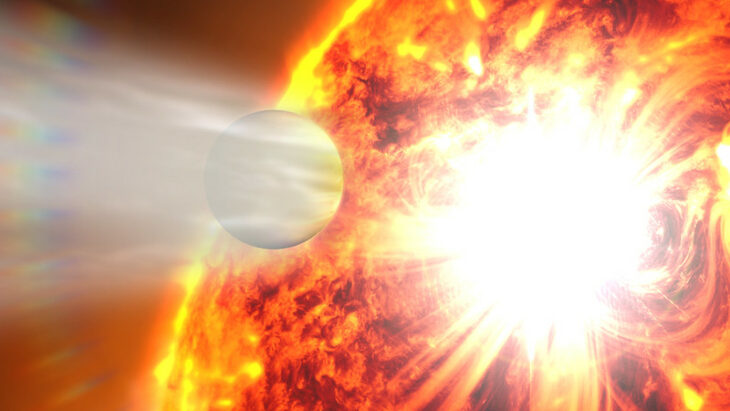In 2020, the Zwicky Transient Facility or ZTF saw a point in the night sky similar to what they might have expected if 2 stars merged, an event called a luminous red nova, but not quite as bright. They identified this event as a subluminous red nova or SLRN. Two years later, a team of astronomers took another look at the same spot in the sky, which astronomers named ZTF SLRN-2020, and found evidence that a star had consumed an orbiting planet.
Previous scientists who looked at the system with near-infrared telescopes found traces of chemicals such as titanium oxide, vanadium oxide, and carbon monoxide, which are evidence of a cool outer sphere surrounding the star after some kind of merger. The event’s brightness was in lower-energy wavelengths, not in the visible wavelengths of light. This wavelength of light is consistent with a merger between a star and a planet somewhere between the mass of Neptune and 10 times the mass of Jupiter, rather than another star.
Stars aren’t alive, meaning this star didn’t reach out and gobbled up a planet. So the team faced the question of what physical mechanism or mechanisms brought the 2 objects together. The 2 scenarios they investigated were that the star swelled up as part of its lifecycle until it reached the orbit of its planet, or that the orbiting planet lost energy and slowly spiralled close to the star until it fell in, a process known as orbital decay.
To evaluate these scenarios, the team did a series of follow-up measurements on ZTF SLRN-2020 with the JWST, specifically using onboard devices called the Near-Infrared Spectrograph and the Mid-Infrared Instrument. They also made ground-based observations with the Near-Infrared Imager on the Gemini North telescope. Combining the observations from these devices presented a full picture of the low-energy light emission patterns coming from ZTF SLRN-2020, giving the team more clues as to the current structure of the system and how it came to be.

Illustration of the ZTF SLRN-2020 system before and after planet engulfment. Left: a Sun-like host star with a nearby Neptune- or Jupiter-like exoplanet. Right: after the planet’s orbit decayed and it fell into the star, the star ejected some material, creating a colder outer shell of dust and a close-by hot disk of dust. Made by the author using Microsoft PowerPoint.
When the astronomers analyzed the patterns they observed, they found 4 notable features: the leftover star was reddish overall, there was a strong presence of high-energy electrons in the star’s hydrogen, there was still a strong presence of carbon monoxide, and there was evidence of phosphine in the star, which is commonly found on gas giants or in material surrounding newborn stars. The team used computer modeling to determine the scenario that would most likely produce these patterns.
From the measurements of the star’s color, they found that ZTF SLRN-2020 started very similar to the Sun, though only about 70% of its size. It would have been too young to start the expansion process that happens near the end of a star’s life, so its planet’s orbit most likely decayed, slowly careening it into the star. This collision would have provided the energy to make the star flare up in 2020 and excite the hydrogen in its outer layers.
They explained that the star would also have ejected some of the material from its planet as part of the collision. The phosphine and carbon monoxide emissions indicated that the ejected material now sits in 2 distinct layers of dust surrounding the star, a cold outer shell and a hot inner disk. The team’s observations showed no sign of any remaining core of the planet still orbiting the star, meaning it must have been fully engulfed rather than only losing its outer layers.
The team labeled this event as a new area for physics since it’s the first planetary engulfment observed and followed up on. The variety of instruments with which these scientists measured the event will provide future researchers who find similar phenomena with a head start on what to look for.


